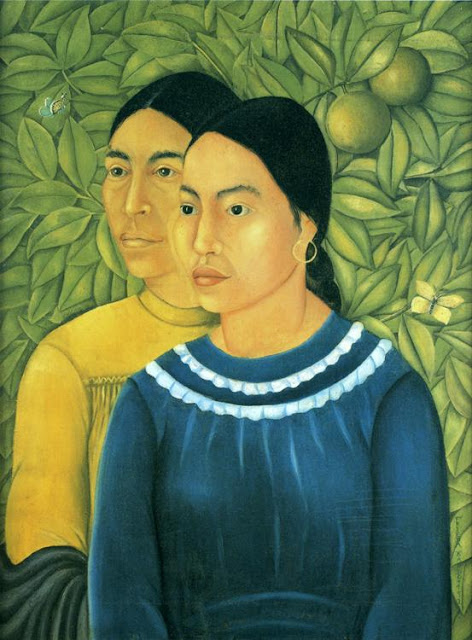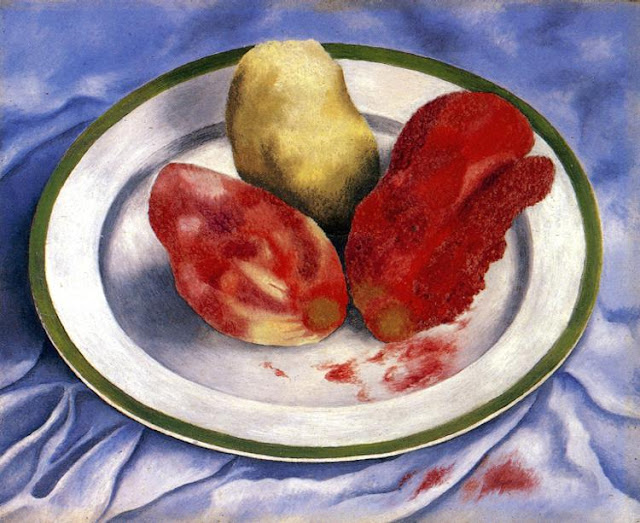Frida Kahlo
Frida Kahlo was born on July 6, 1907, the third of four daughters of Wilhelm Kahlo, a German Jew of Hungarian descent, and Matilde Calderon de Kahlo, a mestizo Mexican. The family lived in a house ("The Blue House") that the parents had built themselves in 1904, in Coyoacan, a suburb of Mexico City.
Frida’s maternal grandfather had been a photographer and had taught her father the craft. Wilhelm, who changed his name to Guillermo when he became a Mexican citizen, set himself up in business and rose to relative prosperity, receiving commissions from the Mexican government. However, the Mexican Revolution, which started in 1910 and would continue for several decades, brought an end to this work, and as a result, Kahlo’s childhood was spent in relative poverty, forcing her to start working at an early age.
In 1913, at the age of 6, Frida contracted polio, which left her right foot crippled and earned her the cruel nickname “Peg-leg Frida.” Kahlo was very sensitive about this deformity, and this would lead her to wear, at first, trousers and, later, long exotic skirts that would become one of her trademarks.
Unlike many artists, Frida did not start painting at an early age. Although her father dabbled in painting as a hobby, his daughter was not particularly interested in art as a career and did not pursue it seriously.
Frida Kahlo received her primary education at the Colegio Aleman, Mexico City's German school. In 1922, she graduated and became a student at the Escuela Nacional Prepatoria (National Preparatory School), rated the best preparatory college in Mexico. Kahlo was one among only 35 female students out of a total of some 2,000. She studied the natural sciences, with the eventual aim of becoming a medical doctor.
It was at the Escuela that she first became acquainted with the ideas of socialism and national-socialism. Kahlo joined a group called the "Cachuchas", so named after the caps they wore. Several members of the group would later become prominent cultural and political figures.
The event that would transform her life and launch her artistic career took place in the September of 1925. Returning home from school with her boyfriend, Alejandro Gomez Arias, the pair was caught in a terrible accident. The bus that they were riding on collided with a tram, killing several people. Kahlo suffered severe injuries and was confined to bed for many months.
It was during this period that she took up the paintbrush, to distract herself from the pain and boredom of her condition. Her parents provided her with a mirror, so that she could serve as her own model, and this was how Kahlo began painting the self-portraits that would dominate her repertoire.
Some of her early works include the Self-Portrait in a Velvet Dress (1926), Portrait of Miguel N. Lira (1927), Portrait of Alicia Galant (1927) and Portrait of My Sister Christina (1928). With their muted colors and largely one-tone backgrounds, these works exhibit the prevailing European influence on Mexican art. This, however, was soon to change.
The ongoing Mexican Revolution was accompanied by a cultural reform, which sought to raise the status of indigenous Indian culture to the same level as the Spanish culture imported from Europe. The evolution of the dry, academic European style into the vibrant, colorful Mexicanist style can easily be seen in Kahlo's work.
By 1928, the painter had recovered sufficiently to lead a mostly normal life and she resumed contact with her old friends, many of whom had by now graduated the Escuela and were at university. It was through them that she got to know Diego Rivera, an established and esteemed painter, twenty one years her elder. The two of them had met before, when Rivera was painting a mural at the Escuela's amphitheatre, in 1922, but had not had any contact since. When Kahlo showed Rivera her work, he was greatly enthused and encouraged her to pursue painting professionally. The two would marry on August 21, 1929.
A year earlier, in 1928, Kahlo had joined the Mexican Communist Party.
By the end of the 1920s, the political climate in Mexico was starting to change. The president Plutarco Elias Calles, who ruled formally from 1924 to 1928, and then held on to power secretly until 1934, cut funding for large mural paintings, leaving Rivera, who specialized in murals, in dire straits, financially. In addition, Calles took repressive measures against political opponents, the Mexican Communist Party among them. Although Rivera had left the party in the 1920s, he was viewed as a sympathizer.
It was for these two reasons that, in 1930, Diego Rivera and Frida Kahlo moved to the United States. There, Rivera hoped to find a better market for his art, as well as safety from possible persecution. The couple would stay in the country for 4 years, traveling and staying in San Francisco, New York City and Detroit, as Rivera received commissions for murals.




































ليست هناك تعليقات:
إرسال تعليق